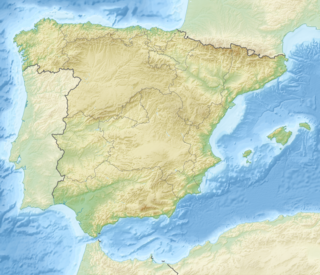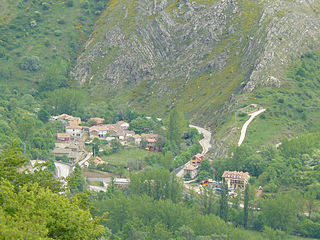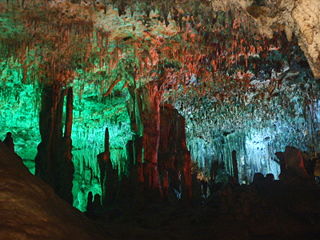 W
WThe Cuevas de la Araña are a group of caves in the municipality of Bicorp in Valencia, eastern Spain. The caves are in the valley of the river Escalona and were used by prehistoric people who left rock art. They are known for painted images of a bow and arrow goat hunt and for a scene depicting a human figure.
 W
WArmintxe Cave in Lekeitio (Spain) is an important Paleolithic rock art site, estimated to date from between 12,000 and 14,500 years ago.
 W
WThe cave of the Barranc (Ravine) del Migdia was discovered in 1989 in Xabia (Spain). At an altitude of around 375 metres on the sunny side of the Montgó, the cave is situated at the head of the ravine after which it is named. The site preserves an important group of schematic rock paintings, as well as multiple graves from the Calcolithic or copper age.
 W
WCanalobre Cave is a karst cave located in the small municipality of Busot, Alicante Province, in the Valencian Community of Spain. It has an estimated area of at least 18,950 m2 (204,000 sq ft). It is one of the largest and one of the most popular caves in Valenciana.
 W
WCueva de los Casares is a cave in Riba de Saelices. Discovered in 1933, it contains a number of paleolithic cave paintings, and is most notable for a series of paintings depicting what some have argued is the earliest representation of human understanding of the reproductive process, featuring images of copulation, pregnancy, childbirth, and family life. Mammoths and other animals feature frequently in the illustrations. It was declared Bien de Interés Cultural in 1935.
 W
WCave of Los Aviones, located at sea level near Cartagena in southeastern Spain, is a paleontology site dating back to the Middle Paleolithic era. It is famous for having yielded in 2010 several perforated and painted seashell beads thought to have been crafted as jewelry by Neanderthals.
 W
WThe Cave of Maltravieso in Cáceres, Extremadura, Spain, was discovered in 1951. It shows traces of human occupation from the Middle Paleolithic. It contains cave art, most notably a total of 71 hand stencils, enumerated in the 1990s using ultraviolet photography, but also linear designs and some animal paintings. In a 2018 study based on uranium-thorium dating, a hand stencil from the Cave of Maltravieso was dated to 64,000 years ago. This would make it Middle Paleolithic art, predating the presence of European early modern humans, with important implications for Neanderthal behavior.
The Cave of Niño is a cave located in Aýna, Spain. It was declared Bien de Interés Cultural in 1997.
 W
WThe Cave of the Angel refers to several cave-related structures located in the Aras mountain range near the town of Lucena, Córdoba province in Spain. The site contains lithic material of an Acheulean typology and dates to that from the Middle Pleistocene to the Upper Pleistocene. There is geological, paleontological, and archaeological evidence indicating an intense and long-term occupation of this site. The numerous bone and lithic remains found in this site, as well as the matrix surrounding them, reveal exposure to fire. This, along with the finding of a wide and deep combustion structure in the stratigraphic profile, support the hypothesis that at the time of the occupation of the site by humans there was processing and consumption of big mammals.
 W
WThe cave of Valporquero (la cueva de Valporquero" is located at the north of the Province of León, near the village of Valporquero de Torío in the municipality of Vegacervera and 47 km away from the capital city, León. Open to the tourism since 1966, the management is done by the Diputación de León.
 W
WThe Santa Cueva de Nuestra Señora de Covadonga is a Catholic sanctuary located in Asturias, northern Spain. It is a cave in the Picos de Europa mountains, which gives its name to the parish of Covadonga in the municipality of Cangas de Onís. The name refers to the sanctuary, dedicated to the Virgin of Covadonga, where the first batlle of the Spanish Reconquest took place in 718.
 W
WCueva Antón is a paleoanthropological and archeological site in the Region of Murcia of southeast Spain. The cave is located about 60 kilometers from the Mediterranean port city of Cartagena inland in the territory of the municipality of Mula. It was eroded by the Río Mula and served as a cave in the Middle Palaeolithic inhabited by Neanderthals. The cave became internationally known in 2010, after a shell at least 43,000 years old with adhering orange pigment was discovered there. The pigment found was interpreted as evidence that the shell was used "in an aesthetic and probably symbolic" way. The find from the Cueva Antón was published together with similar finds from the Cave of Los Aviones; they were named as the first such Neanderthal jewelry found in Europe. The colonization of the Iberian Peninsula by modern man took place only several thousand years after the creation of the jewelry from the Cueva Antón. This site is the last known place where Neanderthal people resided.
 W
WCueva de Bolomor, or Bolomor Cave, is an archaeological site near Tavernes de la Valldigna in the Valencian Community, Spain. It was occupied over a long period of time, between 350,000 and 120,000 years ago.
 W
WCueva de Montesinos is a cave of the Province of Albacete, Spain. At the bottom of the cave is a small lake formed by rainwater filtering through the cave. It has been discovered through a series of experiments and tests that the water in that lagoon is connected by underground streams with the natural park of Ruidera.
 W
WThe Caves of Drach are four great caves that are located in the island of Majorca, Balearic Islands, Spain, extending to a depth of 25 m and reaching approximately 4 km in length. They are in the municipality of Manacor, near the locality of Porto Cristo. They were first mentioned in a letter dated 1338. The four caves, called Black Cave, White Cave, Cave of Luis Salvador, and Cave of the French, are connected to each other.
 W
WThe Coves dels Hams are a Solutional cave system on the east coast of the Spanish Balearic Island of Mallorca. The caves are in the municipality of Manacor, about 1 km to the west of the town of Porto Cristo.
 W
WThe Grotto of Casteret, also known by its Spanish names Gruta de Casteret or Gruta Helada de Casteret, is a limestone ice cave, located high in the Spanish Pyrenees, within the Ordesa y Monte Perdido National Park. Discovered in 1926 by Norbert Casteret, it is known for its Gran Sala which has a frozen lake some 2,000 square metres (22,000 sq ft) in area, its ice formations, and a 20 metres (66 ft) ice wall into a second chamber.
 W
WLas Caldas Cave and the surrounding partial nature reserve is a protected area covering 45 hectares within the Nalón Valley in the Municipality of Oviedo in the vicinity of the towns of La Piñera and Las Caldas.
 W
WThe National Archaeological Museum is a museum in Madrid, Spain. It is located on Calle de Serrano beside the Plaza de Colón, sharing its building with the National Library of Spain.
 W
WOjo Guareña is a karst complex located in the Cantabrian Mountains of Castile and Leon, Spain, declared a natural monument by the government of Castile and Leon in 1996. It is composed of over 90 kilometres (56 mi) of galleries and passages within an area of some 13,850 hectares. The limestone formation containing the system is approximately 100 metres (330 ft) thick and sits on a massive water-resistant layer of marl. The caves were formed in the limestone by erosion sometime within the Coniacian Age. Ojo Guareña was considered the greatest karst system of the Iberian Peninsula until 2009, when a significant length of new passages was discovered in the Mortillano system.
 W
WCueva de La Pasiega, or Cave of La Pasiega, situated in the Spanish municipality of Puente Viesgo, is one of the most important monuments of Paleolithic art in Cantabria. It is included in the UNESCO World Heritage List since July 2008, as part of the inscription: "Cave of Altamira and palaeolithic cave art of Northern Spain."
 W
WThe Praileaitz Cave is located in the municipality of Deba.
 W
WThe Roca dels Moros or Caves of El Cogul is a rock shelter containing paintings of prehistoric Levantine rock art and Iberian schematic art. The site is in El Cogul, in the autonomous community of Catalonia, Spain. Since 1998 the paintings have been protected as part of the Rock art of the Iberian Mediterranean Basin, a UNESCO World Heritage Site. Inscriptions in Northeastern Iberian script and in Latin alphabet indicate that the place was used as a sanctuary into Iberian and Roman times.
 W
WThe Santa Cova de Montserrat is the hillside cave on Montserrat where the Virgin of Montserrat was traditionally hidden during the Moorish invasions and later discovered by shepherds in 880. Its discovery made Montserrat into a pilgrimage destination, and led to the founding of the Santa Maria de Montserrat Abbey.
 W
WThe Santuario de la Cueva Santa, also called la cueva del Latonero, is a Roman Catholic cave-chapel in Altura, Spain. It was made into a chapel by shepherds.
 W
WThe Sidrón Cave is a non-carboniferous limestone karst cave system located in the Piloña municipality of Asturias, northwestern Spain, where Paleolithic rock art and the fossils of more than a dozen Neanderthals were found. Declared a "Partial Natural Reserve" in 1995, the site also serves as a retreat for five species of bats and is the place of discovery of two species of Coleoptera (beetles).
 W
WThe Tito Bustillo Cave is a prehistoric rock shelter located in the small town of Ribadesella, in the autonomous community of Asturias, Spain. The cave was inhabited by humans (cro-magnon) before the year 10,000 BC. Due to the collapse of the rock, the original entrance to the cave was sealed thousands of years ago, which made it possible for preservation of objects, tools and wall paintings that were discovered in 1968. Based on those objects found in the cave, it is known that there was a significant human presence during the Magdalenian culture of the Upper Palaeolithic, but the cave was probably inhabited before that time.